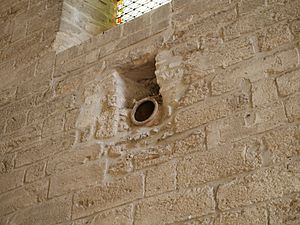Acoustic jar facts for kids
An acoustic jar, sometimes called a sounding vase, is a special ceramic pot. These jars are often found built into the walls, ceilings, and sometimes even the floors of old churches from the Middle Ages. People believed these jars helped make singing sound better inside the church. The idea for them might have come from the writings of an ancient Roman architect named Vitruvius. He wrote about similar jars used in ancient Greek theaters to make actors' voices louder, but we haven't found any real proof of those ancient jars yet.
Contents
How They Were Made
The jars Vitruvius wrote about were made of bronze. They were designed especially for each theater. They were placed in special spaces between the theater seats, making sure nothing touched them. People used math to figure out exactly where to put them. Vitruvius said they should be placed upside down and held up by small wooden pieces.
While Vitruvius mainly talked about bronze jars, these special pots could also be made from earthenware, which is a type of pottery.
History of Acoustic Jars
Ancient Times
The Roman writer Vitruvius described how bronze vases were used in Greek and Roman theaters. These vases were placed in special spots to change how sound traveled.
Vitruvius even mentioned a man named Lucius Mummius. He supposedly destroyed a theater in Corinth and brought the bronze jars back to Rome. He then sold the pieces and used the money for a special offering at a temple.
However, no actual acoustic jars from ancient Greek or Roman times have ever been found by archaeologists.
Middle Ages
The idea of acoustic jars came back during the Middle Ages. We've found examples in about 200 churches, with about half of them in France. These medieval jars look very different from what Vitruvius described. They are made of ceramic and are built right into the church walls.
We learned about their purpose from a old book called the Chronicle of the Celestins of Metz. In 1432, a writer recorded that the church's leader, Brother Odo le Roy, ordered pots to be put into the church choir. He had seen them elsewhere and thought they would make the singing sound better and louder. So, workers installed them in just one day!
These jars were common in areas like Brittany in France. In some places, they were placed in straight lines about three meters (about 10 feet) high on the walls. In England, a group of eleven jars can still be seen high up in the walls of St Andrew's Church, Lyddington in Rutland.
In Norwich, England, special L-shaped ditches were found under the floor of St Peter Mancroft church. These ditches held many acoustic jars. The jars were about 9.5 inches long and 8 inches wide, with a narrower opening. Similar jars were found at another church in Norwich, St Peter Parmentergate, Norwich. At Fountains Abbey in Yorkshire, several earthenware jars were found built into the bottom of the choir screen, with their openings sticking out through the stone.
Did They Really Work?
People have long debated whether these jars actually helped with sound. Thomas Noble Howe, who studied Vitruvius's writings, noted that it's unclear if these vessels made sound louder or quieter. Vitruvius believed they worked with the "laws of physics" and "harmony." However, some experts think Vitruvius might have mistaken an idea for reality, and that these jars might not have been used at all in ancient times.
The usefulness of the medieval jars has also been questioned. The writer of the Metz Chronicle even made fun of the prior for thinking they would improve the choir's sound. Some archaeologists think the jars might have been placed there more as a tradition or offering, rather than for sound reasons.
From a science point of view, there's no clear agreement on how acoustic jars affect sound. It's still an active area of research for people who study sound in ancient places. Some modern tests suggest that the jars might have absorbed certain sound frequencies, acting like a Helmholtz resonator (a type of sound absorber), rather than making sound louder. However, in 2011, some researchers showed that Vitruvius's idea of sound amplification might have been possible with a special model of an ancient acoustic vase.
Modern Uses
In 2015, an artist named Michele Spanghero created a modern art piece called Echea Aeolica in a city park in Syracuse, Italy. This sculpture, made of fiberglass and steel, was inspired by the ancient acoustic jars. It aims to connect with the past and create an "echo from afar." This artwork is permanent and lets people interact with it, using it as a listening device. Because it's outdoors, it also reminds people of acoustic mirrors and Aeolian harps, which are instruments played by the wind.
See also
 In Spanish: Jarra acústica para niños
In Spanish: Jarra acústica para niños


